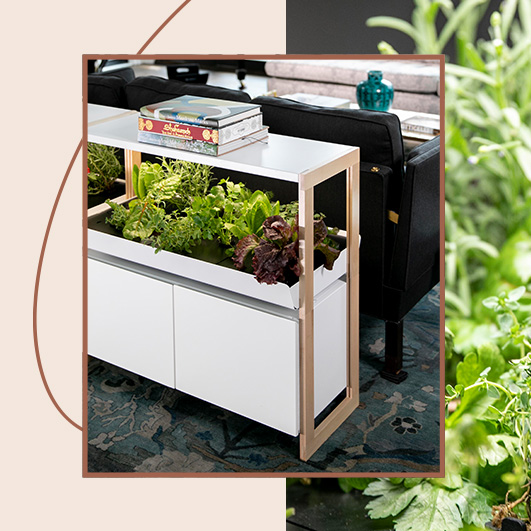This In-Home Smart Garden Brought Me Joy (and Vegetables!) in a Chaotic Year
I can take exactly zero credit for the feat, however. All kudos are due to the founder of the feast, a company called Rise Gardens which makes large in-home smart gardens like mine as well as smaller countertop ones. The version in my kitchen holds a whopping twenty-four plants, which overflow from a base that blends seamlessly in with my decor. That base then comes with little seed pods for various types of vegetables and herbs, which you easily insert into the spaces provided after setting up the system's hydroponics (not easy but not hard, with detailed instructions). Water and nutrients then flow to those seeds via the hydroponic system, which requires no maintenance from you aside from regular refilling.

Shop now: Rise Gardens Single Family Indoor Garden, $549
Cool, right? But like, if that was all there was to this, my plants would definitely still be dead. The real kicker is that the whole thing is connected to an app, which helps you monitor your grows. It tells you when to feed your plants which nutrients—all of which are bought through the Rise store—when to trim them or pinch them down, and when to harvest them. It also alerts you when the tank's water is getting low. So, unless you fail to pay attention to the app, it's actually pretty difficult to mess up—as evidenced by my thriving bounty.
I got my Rise sometime in the early part of the pandemic, and immediately planted all sorts of things. TBH, I did not have high hopes, simply because, as mentioned, I'd never managed to keep anything alive before. But, these plants actually grew! And some of them grew pretty quickly, like the arugula and some of the lettuces. That was extremely gratifying. Others—like the tomatoes—are still not quite ripe yet, but they look absolutely gorgeous.

{{post.sponsorText}}
You technically only have to care for the garden once or twice a week, but I tend to it daily just because it's been one of the few activities offering me moments of quiet sanity in this insane year. Gardening—which has proven mental-health benefits—has truly helped me focus on something other than the terrifying reality in which we've been living since March. And since I've never grown my own food before, there's also been a positive feeling of accomplishment involved.
Plus, my first-ever (successful) garden has helped me to think about food in a different way, too. For starters, it's incredibly satisfying to cull produce from your own kitchen and eat it, and this benefit was only intensified by the fact that it hasn't felt quite safe to shop or eat outside the home at certain points this year. It's also made me think about food waste in a way I only sort of was doing before; I always hated leaving leftovers at a restaurant, but I often let produce go bad before using it, and never really felt all that bad about tossing it because it's typically not that expensive. But after seeing what it takes to grow just one small head of lettuce—in terms of time and care and resources—I have a lot more respect for each and every plant that enters my kitchen.
There are a few caveats, however. If you're cash-strapped, this product might not be the right investment for you. It's done a number on my water and power bill because it requires quite a bit of energy to keep it running 24/7. And I'm not sure the bounty is the most economical, either. Rise Gardens tells me that with a one-tier garden, and assuming you make some mistakes, you can grow 36 pounds of produce a year. The math of it all depends on what you grow and how well, but it costs $10 for a pack of four seed pods.
I've made a few mistakes with my harvests over the past few months. Some of my plants grew bigger than I expected, overshadowing and killing others. And occasionally I've missed harvesting something before it was too late. I also think that for me, the best way to get bang for my buck is to stick to lettuces and herbs rather than tomatoes and peppers—they require less time and energy for what I think is a more useful yield. I can utilize that strategy moving forward to ensure I'm planting what best meets my needs as well as staggering each plant's cycle so that I'm not caught with too much to eat at once.
Overall, I'd say that if you're looking to connect a little more with the Earth from inside your dwelling, either because you don't have a yard or you live somewhere with temperatures too extreme to grow year-round, this is a good investment. It's meditative and productive and adds a certain glow to a space. And you don't have to have a ton of room to house it, either—mine lives comfortably in a 600 square-foot apartment. (It's also available in a variety of sizes, too—from a countertop version to a more expensive triple-decker garden perfect for a large family of vegetable-eaters.)
To say I'm bummed we didn't contain COVID-19 this year so 2021 would be different is an understatement, but I am as excited as I can be to continue experimenting with my garden through these next many months at home. Now the real question: What can I grow next?
Oh hi! You look like someone who loves free workouts, discounts for cult-fave wellness brands, and exclusive Well+Good content. Sign up for Well+, our online community of wellness insiders, and unlock your rewards instantly.
Loading More Posts...